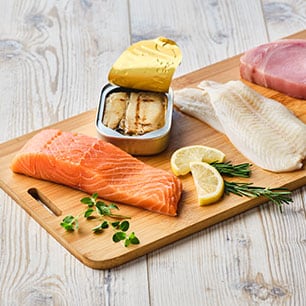
Published February 1, 2025
February is American Heart Month. Research has shown that eating foods with omega-3s can help reduce the risk of heart disease and stroke.1 Omega-3s are essential fats; while the body is unable to produce them, they can be obtained by consuming various foods, including seafood options such as oily, fatty fish.2 Nutritious seafood is not limited to fresh fish. Fish rich in omega-3s can also be frozen, previously frozen, or canned.
Fish high in omega-3 fatty acids may lower triglycerides,3 which is a fat in the blood. Reducing these levels decreases plaque buildup and may lower blood pressure, ultimately responding positively for heart health.
The American Heart Association recommends 1,000 milligrams of EPA (eicosapentaenoic acid) and DHA (docosahexaenoic acid) per day for patients with coronary heart disease, and two meals of oily fish per week for people without heart disease. EPA and DHA are both found in fish.4 Prominent health organizations suggest eating a variety of seafood at least twice a week, aiming to consume an average of 250 to 500 milligrams of omega-3 EPA and DHA per day.
Four fish for supporting heart health.
Sardines
More than 1,000 mg of omega-3s.
These bite-size fish are rich in omega-3s and make great hors d'oeuvres to whet your appetite. You can toss them in a salad, use them in a pasta, or pop a few on your pizza to give your meal an extra punch of flavor.
Salmon
Between 500 and 1,000 mg of omega-3s.
From coho to Atlantic and sockeye salmon, you have a variety of delicious fish to choose from depending on the season. Cover a salmon fillet in panko breadcrumbs and bake, then serve with a zesty squeeze of lemon over the top.
Flounder
Between 250 and 500 mg of omega-3s.
One of the most versatile fish around, this seafood staple has a light texture with a subtly sweet flavor. Baked, pan-fried, oil-poached—no matter how you prepare your meal, you have a tasty way to get your omega-3s.
Catfish
Less than 250 mg of omega-3s.
Catfish is a moist, slightly sweet fish that’s easy to prepare in a handful of delicious ways. Its mild and earthy flavor make it perfect for rich, savory recipes. Try it pan-fried or blackened with a zesty salsa.
Three easy ways to add fish to your weekly meals.
If you’re struggling to fit more seafood into your diet, try incorporating these simple tips into your meal planning.
- Check your schedule. Set a specific day each week to enjoy seafood with your family.
- Remember canned and frozen fish. Always have a backup plan for lunch or dinner. Canned seafood can be a budget-friendly option for a variety of meals such as pasta, tacos, salads, and more.
- Try different serving and prep methods. Seafood does not always have to be grilled! You can prepare seafood more quickly by using appliances like air fryers or having your fish and shellfish steamed in our Seafood department.
And if you don’t eat fish, consider taking a fish oil supplement that contains omega-3 EPA and DHA. Publix offers supplement options to help you get your omega-3s. Always check with your healthcare provider before taking any new supplements.
However you choose to get your omega-3s and benefit your heart’s health, we invite you to allow Publix to be a part of your health journey. If you have any questions, please feel free to email our team of dietitians.
For the love of you.
Choosing how you eat is uniquely personal. It’s about your needs, your preferences, and your goals. As your wellness ally, we’re in your corner with fresh ideas, recipes, and wellness icons that make it easier to shift toward wiser food choices. It’s all about you, at your very best.
Sources
1Fish and Omega-3 Fatty Acids. American Heart Association. August 23, 2024.
2Omega-3 Fatty Acids: An Essential Contribution. American Heart Association. August 23, 2024.
3Yang, Zhi-Hong, Marcelo Amar, Alexander V. Sorokin, Robert D. Shamburek, Nehal N. Mehta, and Alan T. Remaley. Supplementation with Saury Oil, a Fish Oil High in Omega-11 Monounsaturated Fatty Acids, Improves Plasma Lipids in Healthy Subjects. Journal of Clinical Lipidology, Volume 14, Issue 1, 53 - 65.e2.
4Omega-3 Fatty Acids. Cleveland Clinic. November 17, 2022.

 You are about to leave publix.com and enter the Instacart site that they operate and control. Publix’s delivery and curbside pickup item prices are higher than item prices in physical store locations. Prices are based on data collected in store and are subject to delays and errors. Fees, tips & taxes may apply. Subject to terms & availability. Publix Liquors orders cannot be combined with grocery delivery. Drink Responsibly. Be 21. For prescription delivery, log in to your pharmacy account by using the Publix Pharmacy app or visiting
You are about to leave publix.com and enter the Instacart site that they operate and control. Publix’s delivery and curbside pickup item prices are higher than item prices in physical store locations. Prices are based on data collected in store and are subject to delays and errors. Fees, tips & taxes may apply. Subject to terms & availability. Publix Liquors orders cannot be combined with grocery delivery. Drink Responsibly. Be 21. For prescription delivery, log in to your pharmacy account by using the Publix Pharmacy app or visiting